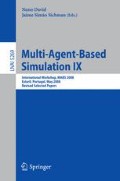Abstract
We use simulation to evaluate agents derived from humans interacting in a structured on-line environment. The data set was gathered from student users of an adaptive educational assessment. These data illustrate human behavior patterns within the environment, and we employed these data to train agents to emulate these patterns. The goal is to provide a technique for deriving a set of agents from such data, where individual agents emulate particular characteristics of separable groups of human users and the set of agents collectively represents the whole. The work presented here focuses on finding separable groups of human users according to their behavior patterns, and agents are trained to embody the group’s behavior. The burden of creating a meaningful training set is shared across a number of users instead of relying on a single user to produce enough data to train an agent. This methodology also effectively smooths out spurious behavior patterns found in individual humans and single performances, resulting in an agent that is a reliable representative of the group’s collective behavior. Our demonstrated approach takes data from hundreds of students, learns appropriate groupings of these students and produces agents which we evaluate in a simulated environment. We present details and results of these processes.
Access this chapter
Tax calculation will be finalised at checkout
Purchases are for personal use only
Preview
Unable to display preview. Download preview PDF.
References
VanLehn, K., Ohlsson, S., Nason, R.: Applications of simulated students: An exploration. Journal of Artificial Intelligence in Education 5(2), 135–175 (1996)
Sklar, E., Davies, M.: Multiagent simulation of learning environments. In: Fourth International Conference on Autonomous Agents and Multi Agent Systems (AAMAS) (2005)
Spoelstra, M., Sklar, E.: Using simulation to model and understand group learning. Agent Based Systems for Human Learning, International Transactions on Systems Science and Applications 4(1) (2008)
Sklar, E.: CEL: A Framework for Enabling an Internet Learning Community. PhD thesis, Department of Computer Science, Brandeis University (2000)
Cypher, A.: Eager: Programming repetitive tasks by example. In: Proceedings of CHI 1991 (1991)
Maes, P.: Agents that reduce work and information overload. Communications of the ACM 37(7), 31–40, 146 (1994)
Balabanović, M.: Learning to Surf: Multiagent Systems for Adaptive Web Page Recomendation. PhD thesis, Stanford University (1998)
Sklar, E., Blair, A.D., Pollack, J.B.: Training Intelligent Agents Using Human Data Collected on the Internet. In: Agent Engineering, ch. 8, pp. 201–226. World Scientific, Singapore (2001)
Hofmann, K.: Subsymbolic user modeling in adaptive hypermedia. In: The 12th International Conference on Artificial Intelligence in Education, Young Researcher Track Proceedings, pp. 63–68 (2005)
Mavrikis, M.: Logging, replaying and analysing students’ interactions in a web-based ILE to improve student modeling. In: The 12th International Conference on Artificial Intelligence in Education, Young Researcher Track, pp. 101–106 (2005)
Merceron, A., Yacef, K.: Educational data mining: a case study. In: The 12th International Conference on Artificial Intelligence in Education (2005)
Jacobs, N., Blockeel, H.: User modeling with sequential data. In: Proceedings of the 10th International Conference on HCI, pp. 557–561 (2003)
Basalto, N., Bellotti, R., De Carlo, F., Facchi, P., Pascazio, S.: Hausdorff clustering of financial time series. Physica A 379, 635–644 (2007)
Zhang, Z., Huang, K., Tan, T.: Comparison of similarity measures for trajectory clustering in outdoor surveillance scenes. In: ICPR (3), pp. 1135–1138 (2006)
Pearl, J.: Probabilistic reasoning in intelligent systems: Networks of plausible inference. Morgan Kaufmann, San Mateo (1988)
Russell, S., Norvig, P.: Artificial intelligence: A modern approach, 2nd edn. Prentice-Hall, Englewood Cliffs (2002)
Author information
Authors and Affiliations
Editor information
Editors and Affiliations
Rights and permissions
Copyright information
© 2009 Springer-Verlag Berlin Heidelberg
About this paper
Cite this paper
Sklar, E., Icke, I. (2009). Using Simulation to Evaluate Data-Driven Agents. In: David, N., Sichman, J.S. (eds) Multi-Agent-Based Simulation IX. MABS 2008. Lecture Notes in Computer Science(), vol 5269. Springer, Berlin, Heidelberg. https://doi.org/10.1007/978-3-642-01991-3_6
Download citation
DOI: https://doi.org/10.1007/978-3-642-01991-3_6
Publisher Name: Springer, Berlin, Heidelberg
Print ISBN: 978-3-642-01990-6
Online ISBN: 978-3-642-01991-3
eBook Packages: Computer ScienceComputer Science (R0)

